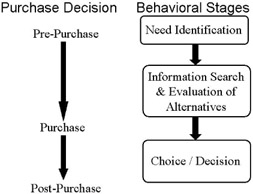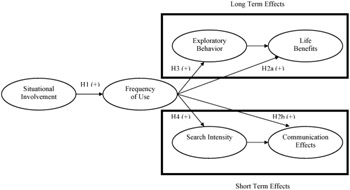Model and Hypotheses
|
| < Day Day Up > |
|
The consumer decision-making process describes the stages a consumer moves through in order to make a purchase decision (see Figure 2). It typically is viewed as being comprised of the following: problem recognition, information search, alternative evaluation, purchase, and post-purchase behavior (Sheth & Mittal, 2004). Problem recognition refers to how a consumer identifies the need to make a decision. Problem recognition can be the result of events such as running out of an existing product or the viewing of a promotional message for a new product. Information search describes the activities in which a consumer might engage and relates also to sources a consumer might consult in order to make a purchase decision. Alternative evaluation is the comparison of multiple options available for satisfying the problem identified at the beginning of the process. Purchase is actually acquiring the option viewed as being most capable of solving the problem. Post-purchase behavior refers to personalization and customization of the purchased product and also the process where the consumer evaluates his or her decision. Whereas all the steps in the consumer decision-making process are important, this chapter focuses specifically on the Internet's impact on consumer information search.

Figure 2: The Consumer Decision-Making Process
The construct of search is important to e-tailers because this step precedes the purchase decision. Even if the consumer does not make an immediate purchase, today's search can influence future decisions by the consumer. That is, the information obtained during information search can influence either current purchase decisions or ones made on a future occasion. Understanding this important decision stage and its influence on consumer behavior might benefit e-tailers today and tomorrow.
Of particular interest to the present study (and its investigation of the impact of the Internet on consumer information search) are constructs such as Situational Involvement, Frequency of Use, Exploratory Behavior, and Search Intensity. Perhaps these constructs can serve to explain a model of online end user information search. Their relationships are presented in the model in Figure 3. This model illustrates a single antecedent variable (situational involvement) and two outcome variables (life benefits and communication effects). Life benefits are long-term outcomes and are expressed in this study as an improvement in the way an individual takes care of his health. Communication effects is a short-term outcome and is expressed here as speaking to a physician or nurse about information recently discovered online.

Figure 3: Model of Web Information Search Health Effects
The concept of involvement has received a great deal of attention in the marketing literature (c.f., Zaichkowsky, 1985; Bloch & Richins, 1983; Houston & Rothschild, 1978) and is of particular relevance to the study of end user's usage of the Internet as an information tool. Involvement may be defined as the extent to which a person finds relevance towards something based on inherent needs, values, and interests (Zaichkowsky, 1985). Involvement has an impact on how much an individual engages in a certain activity. A person with higher involvement will engage in activities related to what they are involved in more often than those with lower involvement.
For example, a consumer with an interest in automobiles might read relevant literature or attend car shows even if he or she is not currently looking to make an automobile purchase. This can be termed ongoing search (Bloch, Sherrell, & Ridgway, 1986) or enduring involvement (Hoyer & MacInnis, 1997). Another consumer without a profound interest in automobiles might never consider information about car purchases until he or she discovers the need to purchase a new vehicle. This consumer's information search can be defined as prepurchase search (Bloch, Sherrell, & Ridgway, 1986) or situational involvement (Hoyer & MacInnis, 1997). That is, some event temporarily increases the relevance or interest towards something (Zaichkowsky, 1985; Bloch & Richins, 1983; Houston & Rothschild, 1978). Novak, Hoffman, & Yung (2000) found that greater involvement (what they call importance) was positively associated with greater focused attention in their model of the customer experience in online environments.
In this context, situational involvement is defined as an individual's focus on a specific need that must be satisfied. For example, if one is looking for a new set of tires for his car, he may discuss where to purchase tires with friends or co-workers or pay more attention to tire advertisements due to heightened awareness of a need. Similarly, a person's health condition may result in increased attention to medical information. Individuals with poorer health are presumed to be more involved with their afflictions and are more likely to seek out information relative to their condition. For instance, a patient suffering from cancer or HIV would have a higher level of involvement with finding information about his or her condition than other individuals without these conditions. Therefore, a particular patient's level of involvement with a health condition will influence his or her frequency of Internet search activities to locate health information. Stated formally,
H1: Situational involvement will have a positive effect on frequency of use.
Frequency of use describes how often an individual uses the Internet to look for information. Frequency of use by a patient will result in greater health information exposure. In other words, the more often an individual uses the Internet to access health information, the more he comes into contact with this type of information. This exposure can yield both long- and short-term outcomes. The long-term outcome is a cumulative effect expressed as the life benefit of using Internet health information to improve health. The short-term outcome is situation specific to that of a patient talking to his health care provider about information obtained online (communication effects).
H2a: Frequency of use will have a positive effect on life benefits.
H2b: Frequency of use will have a positive effect on communication effects.
In terms of the longitudinal outcome of life benefits (in this case, improved health), the quality of the Internet search experience to locate information can also have an impact. In this study, the quality of the experience is contingent on four factors: (1) experience gained by purchasing health products and information via the Internet, (2) maintaining an index ("bookmarks" or "favorites") of frequently visited health information sites, (3) accounting for the source of the health information, and (4) participating in online discussions or chat rooms with individuals concerned with the same health issue. Reeves (2000) found that the Internet impacts the ability of HIV-positive patients to cope with their affliction by promoting empowerment through information and by augmenting social support through chat rooms and a virtual community.
A patient may engage in any or all of the four behaviors that serve to improve the quality of her Internet health information search experience. The cumulative effect of these behaviors can serve to improve the health of the patient. In other words, the more health information a patient gathers, the more informed she is about health issues and thus is more likely to seek her own health improvement. In the model, this cumulative effect is called exploratory behavior. Therefore, it is hypothesized that the long-term quality of the experience (exploratory behavior) mediates the relationship between frequency of use of the Internet and the life benefits obtained.
H3: Exploratory behavior will mediate the frequency of use—life benefits relationship.
In terms of the situation specific outcome of speaking to a doctor about information recently obtained from the Internet, the greater the patient's web-based search intensity, the more he might develop questions about what he read, especially in instances where conflicting information is obtained. On the other hand, the patient might find information about alternative treatments or procedures that he wants to discuss with his physicians. The more information the patient has, the more likely he is to discuss with his physician what he has read on the Internet during a recent information search. Search intensity describes the number of health information websites that a patient visited during his or her last online experience. Therefore, it is hypothesized that the search intensity can mediate the relationship between the patient's frequency of use of the Internet to locate health information and the patient's talking to his health care provider about this information.
H4: Search intensity will mediate the frequency of use—communication effects relationship.
|
| < Day Day Up > |
|
EAN: 2147483647
Pages: 191